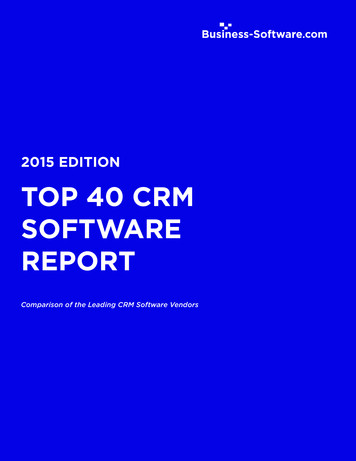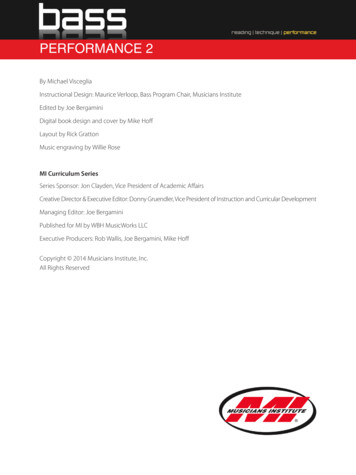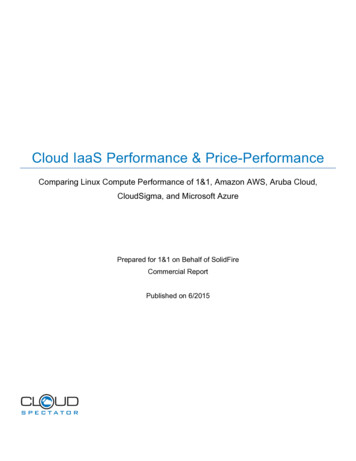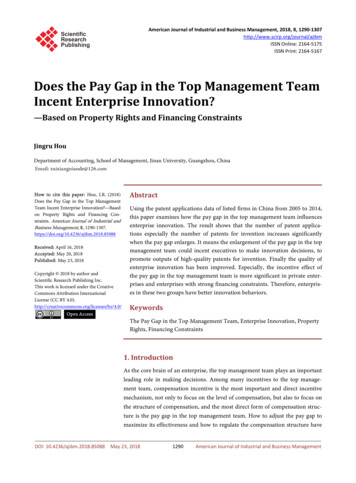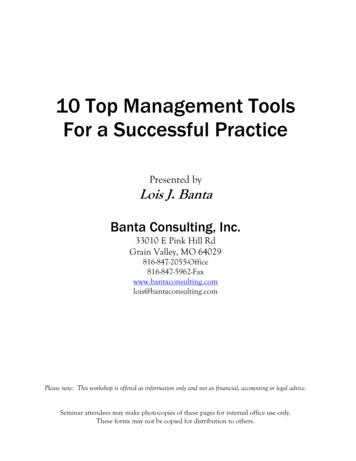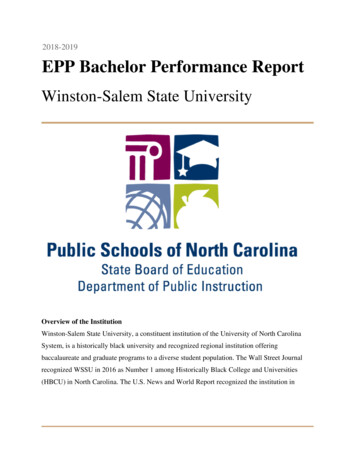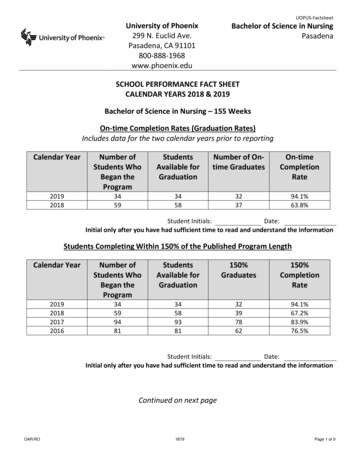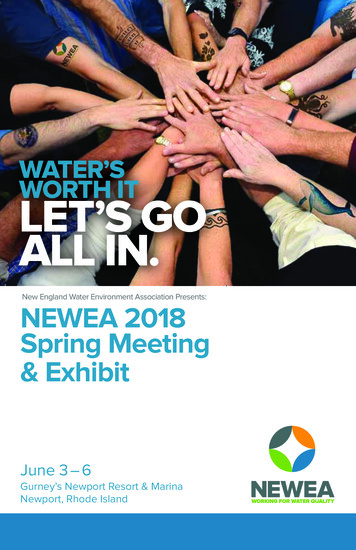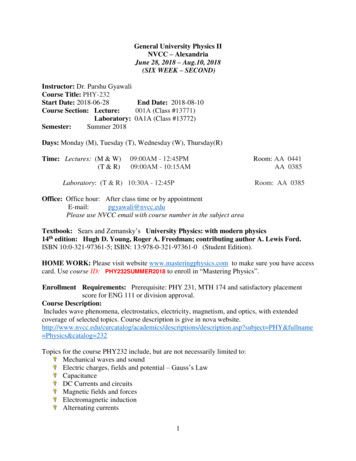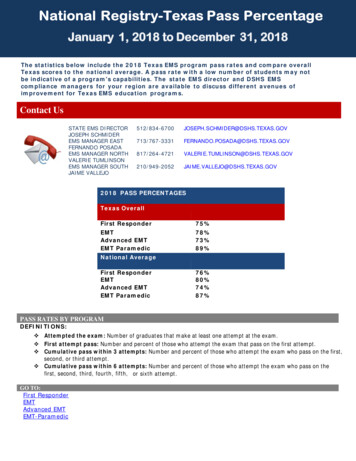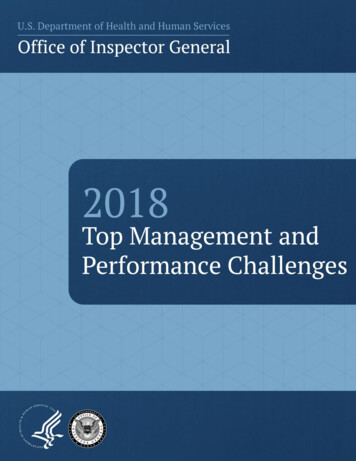
Transcription
IntroductionThe 2018 Top Management and PerformanceChallenges Facing HHS is an annual publication of theDepartment of Health and Human Services (HHS or theDepartment) Office of Inspector General (OIG). In thisedition, OIG has identified 12 top management andperformance challenges (TMCs) facing the Departmentas it strives to fulfill its mission “to enhance the healthand well-being of all Americans, by providing foreffective health and human services and by fosteringsound, sustained advances in the sciences underlyingmedicine, public health, and social services.” Thesetop challenges arise across HHS programs and covercritical HHS responsibilities that include deliveringquality services and benefits, exercising sound fiscalmanagement, safeguarding public health and safety,and enhancing cybersecurity. The Department shouldbe mindful of these challenges and opportunities toaddress them as it undertakes its efforts to ReImagineHHS as part of the Federal Government’scomprehensive plan to reform Government.Top 12 Management and PerformanceChallenges Facing HHS1. Preventing and Treating Opioid Misuse2. Ensuring Program Integrity in MedicareFee-for-Service and EffectiveAdministration of Medicare3. Ensuring Program Integrity andEffective Administration of Medicaid4. Ensuring Value and Integrity inManaged Care and Other InnovativeHealthcare Payment and ServiceDelivery Models5. Protecting the Health and Safety ofVulnerable Populations6. Improving Financial and AdministrativeManagement and Reducing ImproperPayments7. Protecting the Integrity of HHS Grants8. Ensuring the Safety of Food, Drugs, andMedical Devices9. Ensuring Quality and Integrity inPrograms Serving AmericanIndian/Alaska Native Populations10. Protecting HHS Data, Systems, andBeneficiaries from CybersecurityThreats11. Ensuring that HHS Prescription DrugPrograms Work as Intended12. Ensuring Effective Preparation andResponse to Public Health EmergenciesHHS is responsible for a portfolio of more than 1trillion, and its programs impact the lives of virtually allAmericans. To identify the top 12 challenges, wesynthesized our oversight, risk analysis, data analytics,and enforcement work. For each top challenge, weidentify the key components, the Department’sprogress in addressing the challenge, and what needsto be done. There are many cross-cutting issues thattranscend all the TMCs. Examples include improperpayments, the quality of services provided and carereceived by beneficiaries, promoting effective use of health IT, and combatting fraud. Each challengealso lists key OIG resources related to that challenge.Additionally, OIG maintains a list of significant unimplemented OIG recommendations, includinglegislative recommendations, to address vulnerabilities. These recommendations are drawn from OIG’saudits and evaluations. OIG identifies the top unimplemented recommendations that, in OIG’s view,would most positively affect HHS programs in terms of cost savings, program effectiveness andefficiency, and public health and safety.1 More information on OIG’s work, including the reportsmentioned in this publication, are on our website at https://oig.hhs.gov.1OIG, Solutions to Reduce Fraud, Waste, and Abuse in HHS Programs: Top Unimplemented Recommendations, July 2018.Available at ndium/files/compendium2018.pdf.
Table of ContentsTop Management and Performance Challenges Facing HHS1.Preventing and Treating Opioid Misuse .12.Ensuring Program Integrity in Medicare Fee-for-Service and Effective Administrationof Medicare .73.Ensuring Program Integrity and Effective Administration of Medicaid . 134.Ensuring Value and Integrity in Managed Care and Other Innovative Healthcare Paymentand Service Delivery Models . 175.Protecting the Health and Safety of Vulnerable Populations . 216.Improving Financial and Administrative Management and Reducing ImproperPayments . 287.Protecting the Integrity of HHS Grants . 338.Ensuring the Safety of Food, Drugs, and Medical Devices . 379.Ensuring Quality and Integrity in Programs Serving American Indian/Alaska NativePopulations . 4110. Protecting HHS Data, Systems, and Beneficiaries from Cybersecurity Threats . 4511. Ensuring that HHS Prescription Drug Programs Work as Intended. 4812. Ensuring Effective Preparation and Response to Public Health Emergencies . 53
1. Preventing and Treating Opioid MisuseWhy This Is a ChallengeIn 2017, the President declared the opioid crisis a nationwidepublic health emergency. Some analysts estimate that up to 6million Americans could have opioid use disorder.2 In 2017, itis estimated that more than 49,000 opioid-related overdosedeaths occurred in the United States (U.S.), an average of 134deaths per day.Key Components of the Challenge Reducing inappropriateprescribing and misuse of opioids Combating fraud and diversion ofprescription opioids andpotentiator drugs Ensuring access to appropriatetreatment for opioid use disorder Ensuring that funding forprevention and treatment is usedappropriatelyAcross multiple agencies and programs, HHS has manyopportunities to help curb the opioid epidemic. Medicareprovides prescription drug coverage for 45 million Part Dbeneficiaries and Medicaid for 67 million beneficiaries. TheIndian Health Service (IHS) provides care for 2.2 millionbeneficiaries. The U.S. Food and Drug Administration (FDA) oversees the approval and safe use ofprescription drugs. HHS agencies also conduct research and award grants to support healthcareproviders, researchers, and States in their efforts to combat the epidemic.Reducing inappropriate prescribing and misuse of opioidsKey Components of the ChallengeOIG found that almost 460,000 Medicare Part D beneficiaries received high amounts of opioids in 2017.In addition, almost 300 prescribers engaged in questionable opioid prescribing. These prescribersordered opioids for the highest number of beneficiaries at serious risk of opioid misuse or overdose.This does not include prescribing for beneficiaries who have cancer or were in hospice care.Beneficiaries at serious risk include those who received extreme amounts of opioids and those whoappeared to be doctor shopping (i.e., receiving high amounts of opioids from multiple prescribers andmultiple pharmacies).3Medicaid beneficiaries may be especially vulnerable to opioid misuse because they are more likely thannonbeneficiaries to have chronic conditions and comorbidities that require pain relief, especially thosewho qualify because of a disability. In 2016, Medicaid covered nearly 4 in 10 nonelderly adults withopioid addiction, while only 15 percent of the nonelderly adult population is covered by Medicaid. OIGfound that one in six Medicaid beneficiaries in Ohio received an opioid in a 1-year period, and nearly5,000 Ohio beneficiaries received high amounts of opioids.Health disparities and inadequate healthcare services for American Indians and Alaska Natives (AI/AN)have been a subject of concern for the Federal Government for almost a century. AI/AN had the secondhighest rate of opioid overdose deaths in 2015 and 2016.4 IHS is responsible for implementingappropriate controls within its pharmacies to reduce and detect diversion of opioids. OIG has found2Modern Healthcare, “Opioid Use Disorder Cases Triple Government’s Early Estimates,” September 14, 2018. Available 4/NEWS/180919929.3 Extreme is defined as an average daily morphine equivalent dose greater than 240 mg for 12 months.4 Seth PS, et al., Overdose deaths involving opioids, cocaine, and psychostimulants—United States, 2015-2016, MMWR, Vol 67(12) March 30, 2018, pp 349-358.)1
vulnerabilities at some IHS pharmacies that could put patient safety at risk and allow inappropriateprescribing of opioids.Progress in Addressing the ChallengeThe Department has engaged several Operating Divisions in efforts to address inappropriate prescribingand misuse of opioids. Monitoring of prescription drug claims is one tool to prevent inappropriateprescribing and misuse of opioids. The Centers for Medicare & Medicaid Services (CMS) has taken stepsto help reduce misuse of opioids, including strengthening drug utilization reviews, a tool that assistsMedicare Part D sponsors in preventing misuse. In October 2017, States and CMS convened to discussvulnerabilities, mitigation strategies, challenges, and barriers related to State Medicaid opioid efforts. InJune 2018, CMS continued to provide guidance to help States combat the opioid crisis in Medicaid,including information on effective practices to identify substance use disorders covered under Medicaid.The Centers for Disease Control and Prevention (CDC) has awarded funding to States to improveprescription drug monitoring programs (PDMPs), which are statewide databases that track prescriptions.In 2016, IHS implemented a policy requiring prescribers to utilize PDMP data to identify at-risk patients.PDMPs assist in identifying prescribers at risk of inappropriate prescribing and allow authorized users toidentify patients who are obtaining opioids from multiple providers.Education of providers, the industry, and beneficiaries on appropriate prescribing and pain managementalso plays a role in the prevention of opioid abuse. For example, IHS changed its policy regarding opioidprescribing to align with CDC guidelines for prescribing opioids for chronic pain. Furthermore, FDA isencouraging appropriate prescribing of opioid analgesics through the Risk Evaluation and MitigationStrategy (REMS) program for opioid analgesics. The Opioid Analgesic REMS, approved on September 18,2018, includes as the primary component that training be made available to all healthcare providers(HCPs) who are involved in the management of patients with pain, including nurses and pharmacists. Tomeet this requirement, drug manufacturers with approved opioid analgesics will provide unrestrictedgrants to accredited continuing education providers for the development of education courses for HCPsbased on the FDA Education Blueprint for Health Care Providers Involved in the Management or Supportof Patients with Pain (Blueprint). It is expected that continuing education based upon the new Blueprintwill be available to healthcare providers by March 2019.5 To prevent misuse of opioids, HHS haseducated providers and the public about alternative options for pain management. IHS established aNational Committee on Heroin, Opioids, and Pain Efforts to promote appropriate and effective painmanagement, reduce overdose deaths, and improve access to treatment.When opioid use becomes addiction, information on treatment is important. In 2017, HHS launched its5-Point Opioid Strategy to improve access to treatment, improve data, promote better painmanagement, increase the availability of overdose-reversing drugs, and increase research on pain andaddiction. In April 2018, NIH launched the Helping to End Addiction Long-term (HEAL) initiative toimprove treatments for opioid misuse and addiction.What Needs To Be Done HHS agencies should monitor and assess the effectiveness of their ongoing efforts. OIG recommends that CMS continue to develop prescriber educational tools outlining how toappropriately prescribe opioids when medically necessary. As part of this education, CMS should5FDA, “Opioid Analgesic Risk Evaluation and Mitigation Strategy,” September 27, 2018. Accessed nbyDrugClass/ucm163647.htm.2
engage with those providers who may be prescribing inappropriately, to make sure they have thetools to prescribe appropriately. States and IHS should continue efforts to implement and encourage the use of PDMPs.6 Routinelychecking States’ PDMPs is an important step toward improving how opioids are prescribed andreducing opioid misuse, abuse, and overdose. Medicaid beneficiary data should be shared among States and with HHS so that potential patientharm is identified. Beneficiaries can cross State boundaries to obtain opioids and thereby missbeing flagged by a State’s PDMP for potentially excessive opioid use.Combating fraud and diversion of prescription opioids and potentiator drugsKey Components of the ChallengeSeveral years ago, OIG detected—and began taking action to address—a rise in fraud schemes involvingopioids, as well as associated potentiator drugs. Opioid fraud encompasses a broad range of criminalactivity from prescription drug diversion to addiction treatment schemes.OIG investigations of opioid drug diversion, which is the redirection of legitimate drugs for illegitimatepurposes, are on the rise. Diverted opioid drugs are at high risk to be used inappropriately and createsignificant harm, including increasing the risk of overdose. Also at risk for diversion are potentiatordrugs, which are drugs that exaggerate euphoria when combined with opioids and escalate the potentialfor misuse. Prescription opioids indicated to treat pain and those indicated to treat opioid use disorder(particularly, buprenorphine) are also at high risk of diversion.Progress in Addressing the ChallengeOIG, along with State and Federal law enforcement partners, participated in an unprecedented fraudtakedown to combat healthcare fraud and the opioid epidemic in June 2018. More than 160 defendantswere charged with participating in Medicare and Medicaid fraud schemes related to opioids ortreatment for opioid use disorders. These defendants included 32 doctors who were charged for theirroles in prescribing and distributing opioids and other dangerous narcotics.To support public and private sector partners in combatting the opioid crisis, OIG released a toolkitproviding detailed steps for using prescription drug claims data to analyze patients’ opioid levels andidentify certain patients who are at risk of opioid misuse or overdose. Partners such as Medicare Part Dplan sponsors, private health plans, and State Medicaid Fraud Control Units (MFCUs) can now analyzetheir own prescription drug claims data using the methodology OIG developed on the basis of its workon opioids.CMS finalized regulations to guide Medicare plans to implement “lock-in” authority. Lock-in allowsMedicare plans to better manage at-risk beneficiaries’ medication regimens by limiting their access toopioids to certain prescribers and pharmacies. CMS has issued Quarterly Reports of Part D outlierprescribers of opioids and other prescription drugs; these prescribers have a high potential for abuse.Additionally, IHS implemented system and physical controls at certain IHS hospitals to help ensureopioids are secure. These controls help to ensure prescription drugs and pharmacy information areprotected, thus lessening the chance that drugs could be illegally diverted.3
What Needs To Be Done HHS agencies should improve efforts to identify and investigate potential fraud and abuse. Forinstance, CMS should collect comprehensive data from Medicare Part D plan sponsors. CMS should ensure that national Medicaid data are sufficient to detect suspected fraud or abuse. CMS and States should follow up on prescribers with questionable prescribing patterns to ensurethat Medicare Part D and Medicaid are not paying for unnecessary drugs that are being diverted forresale or recreational use. IHS should improve controls at entry points to sensitive areas of its hospitals to protect its pharmacyinventory from unauthorized access. IHS should continue to strengthen its systems controls to ensure unauthorized individuals cannotgain access to sensitive patient information.Ensuring access to appropriate treatment for opioid use disorderKey Components of the ChallengeGiven the scope of the epidemic, access to high quality treatment of opioid use disorder is a priority anda challenge. Only 10 percent of people who need treatment for substance use disorder receive thattreatment.7 Rates of drug overdose deaths are rising in rural areas, surpassing rates in urban areas. Atthe same time, rural areas are often more limited in their access to treatment. The GovernmentAccountability Office found that the regulatory restrictions placed on providers, such as patient limits,and the stigmas related to drug addiction and medication assisted treatment (MAT) are barriers thatmay limit providers’ participation in treatment.Increasing access to MAT and programs must be balanced with the increased risk for fraud involvingaddiction treatment schemes. Fraud committed by providers of treatment for opioid use disorder is aconcern as it both diverts funds and puts beneficiaries at risk.Progress in Addressing the ChallengeHHS has been implementing provisions of the Comprehensive Addiction and Recovery Act of 2016. Thisincludes allowing a temporary expansion of prescribing authority for MAT to other healthcare providersbeyond physicians, including nurse practitioners and physician assistants.HHS agencies have taken steps to expand MAT treatment options and access. The Substance Abuse andMental Health Services Administration (SAMHSA) reviewed the use of three medications (methadone,naltrexone, and buprenorphine) to treat opioid use disorders. In addition, in 2018, the Health Resourcesand Services Administration (HRSA) made 350 million available to expand access to treatment,including MAT, at community health centers. The number of health center clinicians providing MATincreased from 1,700 in 2016 to nearly 3,000 in 2017.8 Further, FDA issued scientific recommendations7SAMHSA, “Receipt of Services for Substance Use and Mental Health Issues among Adults: Results from the 2016 NationalSurvey on Drug Use and Health,” September 2017. Accessed at: DUH-DRFFR2-2016/NSDUH-DR-FFR2-2016.htm. The 2017 National Survey on Drug Use and Health data is estimated to be released inNovember 2018.8 HHS, “HHS Makes 350 Million Available to Fight the Opioid Crisis in Community Health Centers Nationwide,” June 15, 2018.Accessed at: munityhealth-centers.html.4
to encourage the development of MAT drugs.9 FDA also approved the first generic versions ofSuboxone, which may increase access to treatment of opioid dependence.10Additionally, CMS has allowed States to design demonstration projects that increase access to acontinuum of treatment services for opioid use disorders. It also allows State Medicaid agencies toreimburse for treatment at inpatient facilities with more than 16 beds which are otherwise prohibitedby current exclusions.What Needs To Be Done CMS and SAMHSA should monitor the success of their efforts to increase access to MAT. SAMHSA must adequately oversee the waiver process for physicians to prescribe or dispensespecific narcotic medications in settings other than opioid treatment programs. CMS should continue to develop reimbursement policies that foster the development of services toensure that treatment resources and the number of qualified providers are sufficient to providebeneficiaries ready access where and when needed.Ensuring that funding for prevention and treatment is used appropriatelyKey Components of the ChallengeTo build upon the work started u
would most positively affect HHS programs in terms of cost savings, program effectiveness and efficiency, and public health and safety.1 More information on OIG’s work, including the reports mentioned in this publication, are on our website at https://oig.hhs.gov. T
